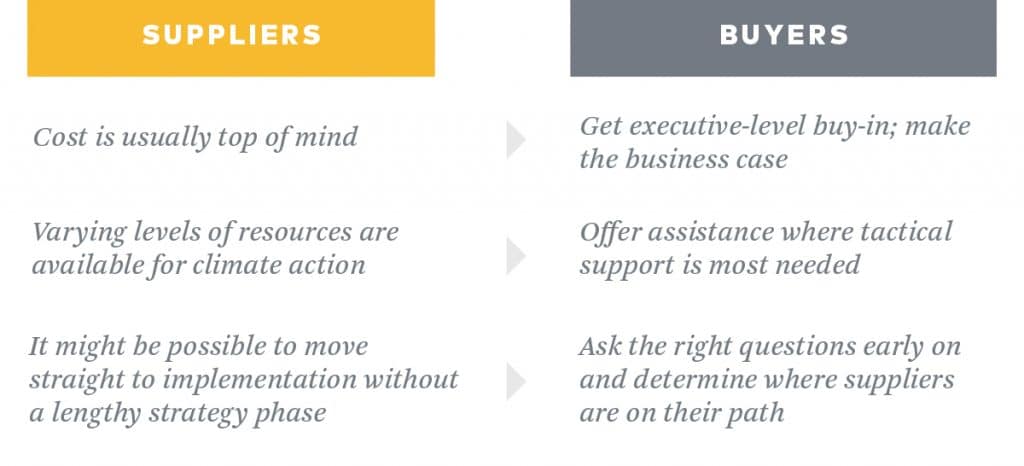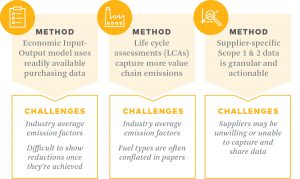As organizations around the world take action to address climate change, many are committing to ambitious climate goals, including net zero carbon emissions, carbon neutrality and science-based targets. However, knowing the proper steps to take to achieve climate goals can sometimes be a challenge, particularly as it relates to scope 3 value chain emissions. Value chain emissions lie outside an organization’s direct operations, and can therefore be more difficult to address — but they often represent the majority of a company’s greenhouse gas (GHG) emissions. There are three key steps to addressing value chain emissions — measurement, materiality and engagement — that will help demystify the process of reducing scope 3 emissions.
Measurement
Though one of the hardest things to do, measurement is a necessary first step for a company to take in the early stages of crafting a value chain emissions reduction plan. There are a few different approaches to consider:
Economic input-output model
An economic input-output model uses readily available data (e.g. company purchases, economic data) and multiplies it by industry-standard emission factors. This is a simple, quick method to determine the order of magnitude for your value chain emissions. However, using a dollar per GHG ($/GHG) factor can limit your ability to quantify your successes if you continue to spend the same amount of money on products.
Life cycle assessments
Industry life cycle assessments (LCAs) can help alleviate the $/GHG limitation by providing industry sector GHG emission factors that can be applied to your company’s purchasing weights to estimate emissions. While the data may not be an exact match for your specific company’s operations, an LCA can be an effective mechanism for layering in more granular data to a Scope 3 inventory.
Supplier-specific (primary) data
In order to fully capture your company’s successful value chain emission reductions, it’s important to eventually integrate more primary supplier-specific information into your measurement process. To do this successfully, you’ll need suppliers who are willing and able to gather the data necessary to make specific calculations for your scope 3 emissions, which requires an effective supplier engagement strategy (more on that in a minute).
Materiality
Once you’ve measured your scope 3 emissions footprint, you will need to make some decisions about where and how you want to begin reducing that footprint. Materiality is the idea of focusing your reduction efforts on the largest source of emissions in your footprint. For example, a consumer packaged goods company might discover that a significant amount of its emissions are generated by fertilizer used during the manufacturing of its food products, since the fertilizer emits the powerful warming gas nitrous oxide. The company can then take action to encourage a shift to a less emission-intensive fertilizer.
In addition to the relative size of an emissions source, it’s also important to consider your company’s sphere of influence over those emissions. A company that sells tea may find that the act of consumers boiling water to make the tea is the largest source of its value chain emissions, but converting consumer households to renewable electricity (or convincing them to drink cold tea) just isn’t an efficient use of the company’s time. In this case, addressing the second (or even third) largest source of emissions where it holds more influence is more practical.
Engagement
 As mentioned above, a key ingredient to a successful value chain emissions reduction plan is supplier engagement. Engagement is where you turn your analysis into action by communicating with suppliers, vendors and even customers about measuring and lowering their scope 1 and 2 emissions (which fall into your scope 3 emissions). There are a variety of paths for engaging partners, both upstream and downstream, to implement emissions reduction programs.
As mentioned above, a key ingredient to a successful value chain emissions reduction plan is supplier engagement. Engagement is where you turn your analysis into action by communicating with suppliers, vendors and even customers about measuring and lowering their scope 1 and 2 emissions (which fall into your scope 3 emissions). There are a variety of paths for engaging partners, both upstream and downstream, to implement emissions reduction programs.
Product innovation/design
Companies can talk to their suppliers about improving their core product in both innovation and design. This could include reducing the number or quantity of inputs, changing to a lower carbon input, or switching to a lower carbon supplier that uses an improved manufacturing process. You could also coordinate with suppliers within your value chain to help improve the way they operate.
Policy advocacy
Organizations can also advocate for policies that support emissions reduction initiatives in their supply chain, such as expanding economically feasible renewable energy options in certain markets.
Incentives
 Another effective tool is the use of incentives. This can be achieved through either a “carrot” or a “stick” approach, though it’s always recommended to start with a “carrot”, which results in a mutual win, win. Examples of carrots include: providing public recognition for climate leaders in the value chain, offering expertise and support to suppliers who are behind the curve, or offering longer contract terms to incentivize investments in climate initiatives. Should these fall flat, a punitive “stick” approach could be effective, such as canceling contracts with non-compliant suppliers that choose to not integrate GHG reduction initiatives into their operations.
Another effective tool is the use of incentives. This can be achieved through either a “carrot” or a “stick” approach, though it’s always recommended to start with a “carrot”, which results in a mutual win, win. Examples of carrots include: providing public recognition for climate leaders in the value chain, offering expertise and support to suppliers who are behind the curve, or offering longer contract terms to incentivize investments in climate initiatives. Should these fall flat, a punitive “stick” approach could be effective, such as canceling contracts with non-compliant suppliers that choose to not integrate GHG reduction initiatives into their operations.
Whatever your approach, communication is key. By collaborating closely with suppliers to understand their goals and motivations, you will be in a stronger position to implement successful value chain interventions. During this collaboration, you’ll likely find that cost is a major factor in your supplier’s decision-making process, so it will be critical to make a business case that spurs buy-in at the executive level. You should also be mindful that your suppliers have varying levels of resources available for climate action. Offering them assistance where tactical support is most needed is a great way to get things moving. Overall, it’s important to ask the right questions early on and determine where suppliers are on their path toward implementation. Some might even surprise you with their readiness.


